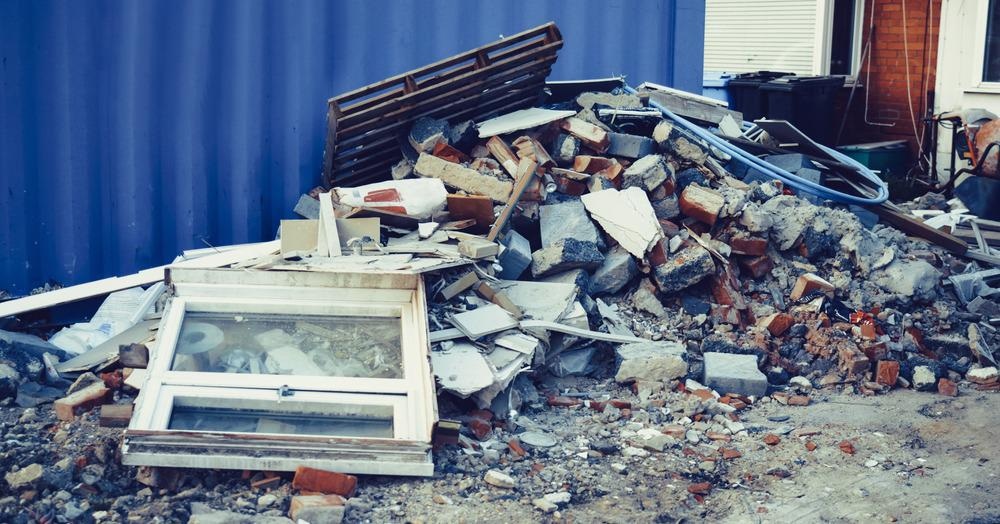The construction industry is one of the most heavily polluting human activities undertaken worldwide today. As the population continues to grow and necessary development continues to take place, we need to look to reduce the construction industry’s carbon footprint.

Kenoteq's construction waste bricks have the same strengths and properties as traditional bricks but are significantly more eco-friendly. Image Credit: Okrasiuk/Shutterstock.com
Kenoteq: Bricks Made from Construction Waste
Scottish start-up Kenoteq is helping to reduce the construction industry’s carbon footprint with its bricks made from construction waste. The K-Briq is made of 90% waste material and is made with an energy-saving unfired brick recycling technique.
The K-Briq was invented by Professor Gabriela Medero, an engineering professor at Edinburgh, Scotland’s Heriot-Watt University. Medero spent 10 years developing the technology to make these recycled bricks.
K-Briqs looks just like a normal building brick. They also weigh the same and have the same mechanical strengths and properties as traditional clay bricks. However, they offer twice as much thermal insulation as Portland cement.
Kenoteq produces the recycled bricks in any color, making them an excellent choice for structural applications where aesthetics are important. The K-Briq can be used in most exterior brick applications.
In principle, K-Briqs can be applied anywhere that traditional clay or concrete bricks are normally used. However, the building industry regulators are yet to fully approve their use in all applications.
The world’s first 90% recycled brick: The K-Briq
Video Credit: Construction Scotland Innovation Centre/YouTube.com
Reducing the Construction Industry’s Carbon Footprint with Sustainable Bricks
The K-Briq’s main appeal to the construction industry will be in the carbon cost savings it can help deliver to projects as large developers and planners alike are increasingly factoring in environmental costs to their benefit analysis for new construction.
K-Briqs creates a fraction of the carbon emissions as traditional clay-fired bricks in their manufacture. Each K-Briq embodies around 72.5 g of CO2, compared to about 570 g for traditional bricks.
This is partly because they are made with an energy-saving unfired technique. The low-carbon production process is similar to concrete manufacture, where bricks are molded from liquid material. The exact details of Kenoteq’s process are currently a trade secret.
The material that goes into the molds is mostly recycled waste from the construction industry, about 90% of the weight of the final brick.
K-Briqs can also be manufactured locally, further helping to reduce the construction industry’s carbon footprint.
Kenoteq Begins Production in Scotland
Kenoteq has begun production at a waste processing facility in Edinburgh, Scotland. From there, the company hopes to serve the local market in Scotland – where up to 85% of bricks used are sources from outside the nation’s borders.
Commercial production is currently underway at the site. At first, Kenoteq intends to manufacture 10,000 K-Briqs per day. Over the first year, the company will scale up production until it can produce two million bricks or more each day by 2022.
Once production has scaled up to this level, the impact on the local construction industry’s carbon footprint will grow even more. At greater scales, Kenoteq believes the embodied energy in its bricks will drop to around 28.5 g of CO2 per brick.
Could Recycled Bricks Meet the Construction Industry’s Demand?
Kenoteq believes that with its technology it could be possible to meet the entire demand for bricks from the UK construction industry today.
However, the company warns that current waste collection and management systems are inadequately prepared to deliver this amount of material to recycled brick manufacturers.
Resolving issues in the incredibly fragmented circular economy of the construction industry would be necessary to get the required volume of recyclable material delivered to the correct sites.
These issues should be addressed soon, the company also warns. Kenoteq anticipates the number of construction and demolition projects to double in the next 30 years.
The Importance of Reducing the Construction Industry’s Carbon Footprint
Researchers have warned that the construction industry needs to take drastic steps to reduce cut levels of embodied carbon in materials and projects. Embodied carbon is the combined weight of the CO2 released into the environment during production.
In construction projects – including in the manufacture, transportation, and demolition needed to deliver them – the industry contributes around 11% of all global carbon emissions.
Kenoteq’s K-Briq technology – if it is as scalable as the company claims – could lend significant weight to efforts to reduce the construction industry’s carbon footprint. By recycling waste construction materials, and simultaneously reducing the energy costs of manufacture and transportation, the K-Briq brings many benefits to bear in one simple product.
References and Further Reading
Aouf, Rima (2021). “Kenoteq Launches Brick Made Almost Entirely of Construction Waste.” Dezeen. [Online] https://www.dezeen.com/2020/03/02/kenoteq-k-briq-brick-construction-waste/
Cousins, Stephen (2021). “Brick that Decimates Embodied Carbon Set to Start Production.” RIBAJ. [Online] https://www.ribaj.com/products/k-briq-kenoteq-low-carbon-brick-heriot-watt-university-sustainability
Rowland, Miles (2019). “Green Report: Construction Must Slash Embodied Carbon.” Construction News. [Online] https://www.constructionnews.co.uk/sustainability/green-report-construction-must-slash-embodied-carbon-23-09-2019/
Disclaimer: The views expressed here are those of the author expressed in their private capacity and do not necessarily represent the views of AZoM.com Limited T/A AZoNetwork the owner and operator of this website. This disclaimer forms part of the Terms and conditions of use of this website.